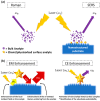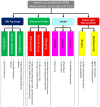Miniaturized Raman Instruments for SERS-Based Point-of-Care Testing on Respiratory Viruses
- PMID: 36004986
- PMCID: PMC9405795
- DOI: 10.3390/bios12080590
Miniaturized Raman Instruments for SERS-Based Point-of-Care Testing on Respiratory Viruses
Abstract
As surface-enhanced Raman scattering (SERS) has been used to diagnose several respiratory viruses (e.g., influenza A virus subtypes such as H1N1 and the new coronavirus SARS-CoV-2), SERS is gaining popularity as a method for diagnosing viruses at the point-of-care. Although the prior and quick diagnosis of respiratory viruses is critical in the outbreak of infectious disease, ELISA, PCR, and RT-PCR have been used to detect respiratory viruses for pandemic control that are limited for point-of-care testing. SERS provides quantitative data with high specificity and sensitivity in a real-time, label-free, and multiplex manner recognizing molecular fingerprints. Recently, the design of Raman spectroscopy system was simplified from a complicated design to a small and easily accessible form that enables point-of-care testing. We review the optical design (e.g., laser wavelength/power and detectors) of commercialized and customized handheld Raman instruments. As respiratory viruses have prominent risk on the pandemic, we review the applications of handheld Raman devices for detecting respiratory viruses. By instrumentation and commercialization advancements, the advent of the portable SERS device creates a fast, accurate, practical, and cost-effective analytical method for virus detection, and would continue to attract more attention in point-of-care testing.
Keywords: Raman scattering; pandemic; point-of-care testing device; respiratory viruses; surface-enhanced Raman spectroscopy.
Conflict of interest statement
The authors declare no conflict of interest.
Figures












Similar articles
-
A Review on SERS-Based Detection of Human Virus Infections: Influenza and Coronavirus.Biosensors (Basel). 2021 Feb 28;11(3):66. doi: 10.3390/bios11030066. Biosensors (Basel). 2021. PMID: 33670852 Free PMC article. Review.
-
Simultaneously ultrasensitive and quantitative detection of influenza A virus, SARS-CoV-2, and respiratory syncytial virus via multichannel magnetic SERS-based lateral flow immunoassay.Nanomedicine. 2023 Jan;47:102624. doi: 10.1016/j.nano.2022.102624. Epub 2022 Nov 1. Nanomedicine. 2023. PMID: 36328340 Free PMC article.
-
SERS Platform for Integrated Enrichment, Isolation, and Identification of Multiple Respiratory Viruses in a Single Assay Using 3D Stereoscopic SERS Tags and Flocked Swabs.Anal Chem. 2024 Aug 13;96(32):13042-13049. doi: 10.1021/acs.analchem.4c01243. Epub 2024 Aug 2. Anal Chem. 2024. PMID: 39092994
-
Multiplexed lateral flow immunoassays using high photostability gap-enhanced Raman nanotags: Highly sensitive, rapid, efficient and portable point-of-care tests.Biosens Bioelectron. 2025 Jun 15;278:117377. doi: 10.1016/j.bios.2025.117377. Epub 2025 Mar 14. Biosens Bioelectron. 2025. PMID: 40107069
-
SERS Based Lateral Flow Immunoassay for Point-of-Care Detection of SARS-CoV-2 in Clinical Samples.ACS Appl Bio Mater. 2021 Apr 19;4(4):2974-2995. doi: 10.1021/acsabm.1c00102. Epub 2021 Mar 17. ACS Appl Bio Mater. 2021. PMID: 35014387 Review.
Cited by
-
Flexible Substrate of Cellulose Fiber/Structured Plasmonic Silver Nanoparticles Applied for Label-Free SERS Detection of Malathion.Materials (Basel). 2023 Feb 9;16(4):1475. doi: 10.3390/ma16041475. Materials (Basel). 2023. PMID: 36837103 Free PMC article.
-
A Review of Magnetic Nanoparticle-Based Surface-Enhanced Raman Scattering Substrates for Bioanalysis: Morphology, Function and Detection Application.Biosensors (Basel). 2022 Dec 27;13(1):30. doi: 10.3390/bios13010030. Biosensors (Basel). 2022. PMID: 36671865 Free PMC article. Review.
-
Preparation of Hybrid Magnetic Nanoparticles for Sensitive and Rapid Detection of Phorate Residue in Celery Using SERS Immunochromatography Assay.Nanomaterials (Basel). 2024 Jun 18;14(12):1046. doi: 10.3390/nano14121046. Nanomaterials (Basel). 2024. PMID: 38921922 Free PMC article.
-
Application of Surface-Enhanced Raman Spectroscopy Combined with Immunoassay for the Detection of Adrenoceptor Agonists.Foods. 2024 Jun 8;13(12):1805. doi: 10.3390/foods13121805. Foods. 2024. PMID: 38928747 Free PMC article. Review.
-
Quantification of Antiretroviral Drug Emtricitabine in Human Plasma by Surface Enhanced Raman Spectroscopy.ACS Omega. 2024 Nov 25;10(5):4315-4325. doi: 10.1021/acsomega.4c06162. eCollection 2025 Feb 11. ACS Omega. 2024. PMID: 39959057 Free PMC article.
References
-
- Singh R. CV raman and the discovery of the raman effect. Phys. Perspect. 2002;4:399–420. doi: 10.1007/s000160200002. - DOI
-
- Long D.A. Early history of the raman effect. Int. Rev. Phys. Chem. 1988;7:317–349. doi: 10.1080/01442358809353216. - DOI
-
- Adar F., Delhaye M., DaSilva E. Evolution of instrumentation for detection of the raman effect as driven by available technologies and by developing applications. J. Chem. Educ. 2007;84:50. doi: 10.1021/ed084p50. - DOI
-
- Sweedler J.V. Charge transfer device detectors and their applications to chemical analysis. Crit. Rev. Anal. Chem. 1993;24:59–98. doi: 10.1080/10408349308048819. - DOI
Publication types
MeSH terms
Grants and funding
LinkOut - more resources
Full Text Sources
Other Literature Sources
Medical
Research Materials
Miscellaneous

